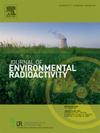In situ observation and theoretical study of temporal variations in radon exhalation rates from the gypsum board of a cavity wall: a comparison with a solid concrete wall
IF 2.1
3区 环境科学与生态学
Q3 ENVIRONMENTAL SCIENCES
引用次数: 0
Abstract
Building materials are one of the most important indoor radon sources, prompting research into their radon exhalation rate (JRn). Most previous studies have relied on laboratory tests using pieces or blocks of materials such as concrete and brick. However, creating samples that mimic real cavity walls, defined as walls with a cavity between the two panels of the associated building material, has been challenging owing to structural complexities. In this study, we conducted the first long-term in situ measurement of JRn from the interior board of a common Japanese cavity wall comprising a thin gypsum board (interior wall), air/insulation, and concrete (exterior wall). Results indicated clear diurnal and seasonal variations in the observed JRn data. In general, the highest and lowest JRn values were observed in summer and winter, respectively, exhibiting the same pattern as that observed for thick solid concrete walls analyzed in our previous in situ study. Interestingly, JRn values increased during the day in summer and at night in winter, contrasting with the stable JRn value observed for the thick solid concrete walls over several days. Theoretical calculations indicated that in this case study, JRn was predominantly driven by diffusion, not by advection. These results could be explained by considering the wall thickness, diffusivity, and boundary conditions of radon activity concentrations. Our findings can help the selection and refinement of input parameters for radon sources when modeling the spatiotemporal dynamics of indoor radon in buildings. More in situ tests in diverse buildings are essential in the future.
洞穴壁石膏板氡呼出率时间变化的现场观察和理论研究:与固体混凝土墙的比较
建筑材料是室内最重要的氡源之一,人们对建筑材料的氡释放率进行了深入的研究。以前的大多数研究都依赖于使用混凝土和砖等材料的碎片或块的实验室测试。然而,由于结构的复杂性,创建模拟真实空腔墙的样品一直具有挑战性,空腔墙定义为两个相关建筑材料面板之间的空腔墙。在这项研究中,我们首次对日本常见的由薄石膏板(内墙)、空气/保温材料和混凝土(外墙)组成的普通空心墙的内板进行了长期的原位测量。结果表明,观测到的JRn数据存在明显的日变化和季节变化。总体而言,最高和最低的JRn值分别出现在夏季和冬季,这与我们之前在原位研究中分析的厚实心混凝土墙的情况相同。有趣的是,JRn值在夏季白天和冬季夜间增加,而厚的固体混凝土墙的JRn值在几天内保持稳定。理论计算表明,在本研究中,JRn主要由扩散驱动,而不是平流驱动。这些结果可以通过考虑氡活度浓度的壁厚、扩散率和边界条件来解释。研究结果有助于在模拟室内氡时空动态时选择和优化氡源输入参数。在未来,在不同的建筑中进行更多的现场测试是必不可少的。
本文章由计算机程序翻译,如有差异,请以英文原文为准。
求助全文
约1分钟内获得全文
求助全文
来源期刊

Journal of environmental radioactivity
环境科学-环境科学
CiteScore
4.70
自引率
13.00%
发文量
209
审稿时长
73 days
期刊介绍:
The Journal of Environmental Radioactivity provides a coherent international forum for publication of original research or review papers on any aspect of the occurrence of radioactivity in natural systems.
Relevant subject areas range from applications of environmental radionuclides as mechanistic or timescale tracers of natural processes to assessments of the radioecological or radiological effects of ambient radioactivity. Papers deal with naturally occurring nuclides or with those created and released by man through nuclear weapons manufacture and testing, energy production, fuel-cycle technology, etc. Reports on radioactivity in the oceans, sediments, rivers, lakes, groundwaters, soils, atmosphere and all divisions of the biosphere are welcomed, but these should not simply be of a monitoring nature unless the data are particularly innovative.
 求助内容:
求助内容: 应助结果提醒方式:
应助结果提醒方式:


